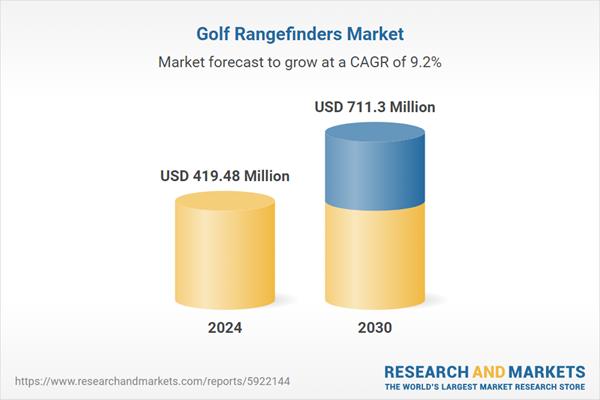Speak directly to the analyst to clarify any post sales queries you may have.
10% Free customizationThis report comes with 10% free customization, enabling you to add data that meets your specific business needs.
Golfers, both amateurs and professionals, seek tools that enhance their game by providing precise yardages and aiding in course management. Rangefinders have become indispensable for golfers looking to improve their shot-making decisions, club selection, and overall performance on the course. The demand for rangefinders stems from the desire to minimize errors and optimize shot accuracy, contributing to the market's expansion. Rangefinders offer golfers convenience and simplicity in obtaining yardage measurements, replacing traditional methods like yardage books or relying solely on course markers.
The user-friendly nature of these devices, with simple interfaces and intuitive controls, appeals to golfers of varying skill levels, making them accessible tools for improving gameplay. The market is characterized by intense competition among manufacturers striving to innovate and introduce feature-rich rangefinders. Companies focus on enhancing accuracy, battery life, durability, and adding value through features such as slope compensation, weather resistance, and compatibility with wearable devices. Continuous technological advancements drive the market, with manufacturers regularly introducing newer models with improved functionalities.
The increasing popularity of golf as a recreational sport and the participation of a tech-savvy younger demographic drive the demand for golf rangefinders. Golfers' preferences for devices that offer quick and precise yardage readings, aiding in their decision-making during rounds, propel the growth of this market. The acceptance of rangefinders in golf tournaments, including professional events, further validates their utility and fosters greater adoption among golfers.
Their integration into the sport's official rules signifies recognition of their role in enhancing gameplay without compromising the integrity of the game. Overall, the global golf rangefinders market is witnessing continuous growth driven by technological advancements, golfer preferences for accuracy and convenience, and the increasing acceptance of these devices within the sport. As technology continues to evolve, rangefinders are expected to remain essential tools for golfers seeking to improve their performance on the course.
Key Market Drivers
Technological Advancements and Innovations
Technological advancements stand as a primary driver fueling the growth of the global golf rangefinders market. The evolution of rangefinder technology has revolutionized the game of golf, offering players accurate distance measurements, enhancing their decision-making on the course, and ultimately improving performance. One pivotal innovation driving this market is the integration of laser and GPS technologies in golf rangefinders. Laser rangefinders use laser beams to measure distances accurately to specific points on the golf course, providing golfers with precise yardages to targets like flags or hazards.On the other hand, GPS-based rangefinders utilize satellite signals to offer aerial views of the course, along with yardages to various points, including front, center, and back of greens, bunkers, and water hazards. The fusion of these technologies in hybrid rangefinders provides golfers with comprehensive and detailed course information, catering to different player preferences and needs. Moreover, the integration of artificial intelligence (AI) and data analytics in modern rangefinders has enhanced their functionality. Advanced algorithms process data to offer more accurate readings, factor in environmental conditions, and provide insights for shot planning. Some rangefinders even offer features like shot tracking, club recommendations, and statistical analysis, allowing golfers to optimize their strategies and improve their game over time.
Key Market Challenges
Price Sensitivity and Affordability
One of the foremost challenges in the golf rangefinders market is balancing advanced technology and affordability. Rangefinders equipped with cutting-edge features such as slope compensation, GPS integration, and laser precision often come with higher price points. Golfers, both enthusiasts and professionals, seek accurate and reliable rangefinders for improving their game but may face budget constraints when purchasing these devices. The demand for rangefinders that offer comprehensive functionalities at competitive prices poses a challenge for manufacturers. While high-end models cater to the needs of serious golfers, there is a substantial segment of the market that seeks affordable yet reliable options. Balancing cost-effectiveness without compromising on quality and accuracy remains a persistent challenge for manufacturers aiming to cater to diverse consumer segments.Key Market Trends
Technological Advancements Redefining Accuracy and Features
Technological innovations stand at the forefront of shaping the golf rangefinders market. Manufacturers consistently integrate cutting-edge technologies to enhance accuracy, ease of use, and functionality. Laser and GPS-based rangefinders have seen significant advancements, with laser rangefinders becoming more compact, offering faster readings, and improving target acquisition. GPS rangefinders leverage satellite positioning to provide precise distance measurements, offering additional features such as hole mapping, course layout, and hazard identification. Moreover, integration with smartphone apps allows golfers to access detailed course data and receive real-time updates, enhancing their overall gameplay experience.In recent years, hybrid rangefinders that combine both laser and GPS technologies have gained traction. These hybrids offer the accuracy of laser rangefinders with the added convenience of GPS functionality, providing golfers with comprehensive distance information and course mapping capabilities in a single device. Furthermore, the integration of Artificial Intelligence (AI) and machine learning algorithms has contributed to rangefinders' ability to analyze terrain, provide personalized recommendations, and improve shot planning. These technological enhancements continue to redefine the capabilities of golf rangefinders, catering to golfers seeking precise and data-driven insights to elevate their game.
Key Market Players
- Callaway
- Nikon Corporation
- Bushnell Corporation
- Golf Buddy
- TecTecTec USA
- Skyhawk Technologies LLC
- ZEISS International
- Wosports
- Laser Link
- Leupold & Stevens Inc
Report Scope:
In this report, the global golf rangefinders market has been segmented into the following categories, in addition to the industry trends which have also been detailed below:Golf Rangefinders Market, By Type:
- Laser
- GPS
Golf Rangefinders Market, By Application:
- Beginners
- Professionals
Golf Rangefinders Market, By Distribution Channel:
- Online
- Offline
Golf Rangefinders Market, By Region:
- North America
- United States
- Canada
- Mexico
- Europe
- France
- United Kingdom
- Italy
- Germany
- Spain
- Asia-Pacific
- China
- India
- Japan
- Australia
- South Korea
- South America
- Brazil
- Argentina
- Colombia
- Middle East & Africa
- South Africa
- Saudi Arabia
- UAE
- Turkey
- Egypt
Competitive Landscape
Company Profiles: Detailed analysis of the major companies present in the global golf rangefinders market.Available Customizations:
With the given market data, the publisher offers customizations according to a company's specific needs. The following customization options are available for the report.Company Information
- Detailed analysis and profiling of additional market players (up to five).
This product will be delivered within 1-3 business days.
Table of Contents
Companies Mentioned
- Callaway
- Nikon Corporation
- Bushnell Corporation
- Golf Buddy
- TecTecTec USA
- Skyhawk Technologies LLC
- ZEISS International
- Wosports
- Laser Link
- Leupold & Stevens Inc.
Table Information
| Report Attribute | Details |
|---|---|
| No. of Pages | 181 |
| Published | September 2025 |
| Forecast Period | 2024 - 2030 |
| Estimated Market Value ( USD | $ 419.48 Million |
| Forecasted Market Value ( USD | $ 711.3 Million |
| Compound Annual Growth Rate | 9.2% |
| Regions Covered | Global |
| No. of Companies Mentioned | 10 |









